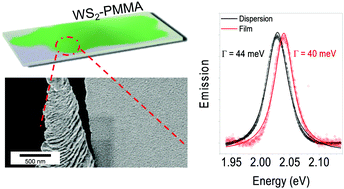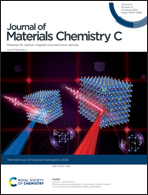Preparation of WS2–PMMA composite films for optical applications†
Abstract
Thus far, research activities of 2D materials in optics, photonics and optoelectronics predominantly focus on micromechanically cleaved or grown nanosheets. Here, we show that high quality liquid-exfoliated nanosheets offer an alternative approach. Starting from well-defined, monolayer rich WS2 dispersions obtained after liquid exfoliation and size selection in aqueous surfactant, we present an optimised protocol facilitating transfer of the nanosheets to a polymer solution in organic media. From such dispersions, we fabricate WS2–polymer thin films by spin coating. The characteristic photoluminescence of WS2 monolayers is retained in the film at 2.04 eV without broadening (line width 40 meV) or significant changes in the line-shape. This confirms that nanosheet aggregation is efficiently prevented on transfer and deposition. The films are extremely smooth and uniform over large areas with a root mean square roughness <0.5 nm. To demonstrate the potential in optical applications, the nonlinear optical response was studied, revealing promise as optical limiter. In addition, we show that the photoluminescence can be manipulated by coupling the exciton response to cavity photons in a Ag microcavity.

- This article is part of the themed collection: Journal of Materials Chemistry C Emerging Investigators


 Please wait while we load your content...
Please wait while we load your content...